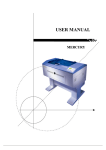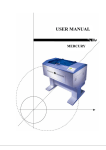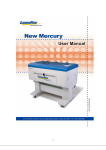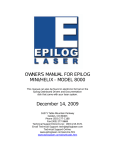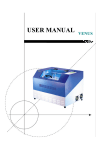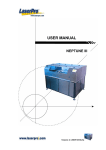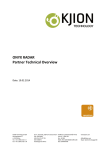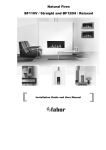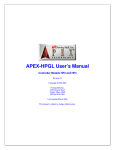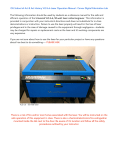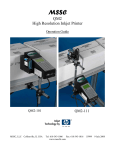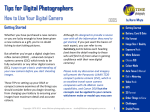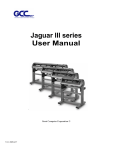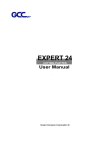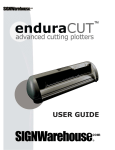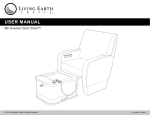Download Software Operation
Transcript
NOTICE For Firmware (V1.1 and later version), when under the Single File Mode, the file can be repeated if you choose to redo it. After the work is completed, the machine will be back to the “STOP” status. The same file will be processed again if you press the “START” key again. One thing that has to take into consideration is that the file size has to be smaller than 15.9 MB (if memory buffer for your machine is 16 MB) or 63.9 MB (if the memory buffer you have is 64 MB). If you choose to start with a new file, you would have to press the “DEL FILE” button twice to clear out the memory. Then the machine will be ready to receive new data again. Content UNPACKING QUICK MENU I. INTRODUCTION Principles of CO2 Laser ---------------------------------Safety ------------------------------------------------------Frequently Asked Questions --------------------------Front View ------------------------------------------------Back View ------------------------------------------------Motion System -------------------------------------------Lens and Manual Focus Gauge-------------------------- 1 1 3 4 5 6 7 II. RECOMMENDED CONFIGURATION Computer --------------------------------------------------- 8 Scanner ----------------------------------------------------- 8 Software ---------------------------------------------------- 8 III. HARDWARE INSTALLATION Cabling Connection--------------------------------------- 9 Exhaust Vent ---------------------------------------------- 10 IV. SOFTWARE INSTALLATION ---------------------- 11 V. OPERATION Environment ----------------------------------------------- 12 Flexible Utility of Your Memory Buffer--------------- 12 Multiple File Mode / Single File Mode ---------------- 13 Start to Operate-------------------------------------------- 14 Control Panel ---------------------------------------------- 15 Software Operation -------------------------------------- 31 VI. BASIC MAINTENANCE ------------------------------ 42 VII. TROUBLE SHOOTING ------------------------------- 45 APPENDIX A. Specificaton B. Application Parameters(I) C. Application Parameters(II) UNPACKING Caution: The weight of LaserPro JUPITER is about 115 kg (253 ponds). To prevent damage to machinery or injury to workers, please get assistance. Do not lift the equipment alone. Please save the original shipping carton in case any returning service is needed. Please inspect what you have received from the shipped carton by comparing with the following listed items. Unpacking inspection Your package should contain the following items: ITEM QUANTITY Cleaning Set cotton swab lens cleaner lens tissue (lint free) 1 pack 1 1 1 1.5” Manual Focus Gauge (blue color) AC Power Cord 1 Print Port Cable 1 LaserPro JUPITER Driver 1 Mirror (for X, Y-axis Mirror) 1 Engraving Samples 1 pack i Unpacking Steps Step 1. Using an M12 open end or impact wrench, unscrew and remove the 4 sides and the top of the crater in the order as specified in the following figure. Step2. Use one of the removed panels to form a slope and then roll the machine out of the crater base. Step3. Save the crater for shipping in case any returning service is needed. QUICK MENU 1. Connect air exhaust system. 2. Setup computer and connect with engraving system properly. 3. Turn ON host computer system. 4. Install the Jupiter Driver. (for the first time use only) 5. Use Windows-based program (such as CorelDRAW, PhotoShop, PhotoPaint, Illustrator, CASmate, Signlab, EasySign, AutoCAD, etc.) to operate with the engraver. 6. Turn ON engraver. The working table moves down 50mm aaproximately after system initialization and the lens carriage moves to the home position (upper left corner). 7. Auto-focusing: under STOP status, put work-piece on the table, move X-axis (Please refer to Fig. 7) and carriage by arrow keys to locate the lens carriage above the engraving material (holding carriage by hands for prompt moving is acceptable under STOP condition but not recommended). Press AUTO FOCUS the table will move up then down to the focal position automatically. 8. The following is an example by using CorelDRAW V.7.0. Layout Page Setup Set from Printer, choose Portrait OK Edit desired file (picture etc.) File Print Properties Options, choose desired Mode (refer to Fig. 13) then set up proper resolution, power and speed OK Print File name is shown on LCD then press START. (Please refer to page 14, Start to Operate, for detail operation in different mode selection) NOTICE: 1. When operating with CorelDRAW V.8.0, please choose Landscape for Page Setup when X > Y ; choose Portrait when X < Y O.K.. 2. When using the available artworks from the Clipart of CorelDRAW, to prevent the hidden vector lines shown on your engravings. Please do as follows: CorelDRAW, choose file from Clipart Bitmaps Convert to Bitmap Click Color then choose Grayscale Ok 3. In order to match Jupiter driver’s color. Make sure your CorelDRAW V.8.0 or V.9.0 the ‘Calibrate colors for display ‘ is disable. Please fallow the steps: Tools Options Global Disable ‘Calibrate colors for display ‘ iv Color Management OK. NOTE: If the memory buffer is set up in Single file mode, under START condition, the engraver will start to engrave/cut upon receiving a file. While if the memory buffer is set up in Multiple File mode, receiving at least one complete file then press START to start a job (refer to page 14, Start to Operate). Choices of DPI must be the same for both editing and printing out a file. Turn on the air exhausting system before engraving. The maximum loading weight of working table is 10 kg. When 3D engraving or cutting materials that easily caught on fire, such as acrylic, wood or paper, it is advised to have Air Compressor turned on to prevent flame. v I. INTRODUCTION Principles of CO2 Laser LASER is a Light Amplification by Stimulated E mission of Radiation. A CO2 laser works by exciting the molecules of a carbon dioxide gas mixture. To engrave, the beam is focused through a lens. The intensive beam can vaporize the surface of the material leaving an engraved image or, in some cases, cutting through the material. Safety The safety rating of Class 1 by CDRH means that the laser beam is enclosed in a cabinet and has safety interlock mechanisms to protect the operator from injury. While when a class 1 laser system equipped with a red dot pointer which allows you to position laser beam, the safety rating turns into Class 3a due to the red beam is laser light. A few extra safety precautions; namely, avoid placing your eyes in the red beam path, is required. l Precaution 1. Do not attempt to modify or disassemble the laser system at any time. 2. Always wear appropriate safety goggles especially when operation, especially engraving with mirrors or coated metals such as enameled brass and anodized aluminum. NOTE: Each LaserPro laser machine is equipped with a safety goggle, if you need another one, please contact LaserPro for it or try to get one that meets the following specification. 190-398 nm OD5+ 10,600 nm OD5+ Visible light transmission: 92.9% 3. Good ventilation is required to remove odors and vaporized materials to the outside of the building or structure. An exhausted system is recommended. 4. Invisible intensive laser radiation may cause physical burns or sever eye damage. Always read the manual and caution labels carefully before operation. -1 - 5. Do not work with reflective metals, heat sensitive surfaces or other materials that may produce toxic substances, such as PVC and Teflon. 6. A fire extinguisher should be available on hand at any time. 7. Never leave the machine unattended during operation. 8. Follow the recommendations for maintaining and cleaning your system. Not only will this enable you to engrave efficiently, it will ensure that your machine runs safely as well. -2 - l Fire Precaution 1.When 3D engraving and cutting materials that easily caught on fire, such as acrylic, wood or paper, it is advised to have air compressor turned on to prevent flame. 2.If cutting table, or honey comb table, is used for cutting purpose, do not leave any material underneath, as when material at top is cut through, the material at below will be burned easily due to trapped heat. 3.It is not encouraged leaving the cutting job unattended, especially with materials mentioned above. l Warning Label DANGER INVISIBLE LASER RADIATION WHEN OPEN AND INTERLOCK FAILED OR DEFEATED AVOID EYE OR SKIN EXPOSURE DIRECT OR SCATTERED RADIATION On the center of the top door. WARNING!! Do not use reflective metals, heat sensitive surfaces or other materials that may produce toxic substances, such as PVC and Teflon. Any corrosion caused by working on an unsuitable substances will not be covered in the warranty. On the front center of the top area. CAUTION AVOID PLACING YOUR EYES IN THE RED BEAM PATH -3 - On the front center of the top door. -4 - Frequently Asked Questions 1. What materials can be processed by CO 2 laser? Virtually any materials such as acrylic, wood, fabrics, glass, leather, marble, stone, rubber stamps, paper products, coated metals, plastics (especially micro plastic developed by IPI, Spectrum and Rowmark etc.) other hard-surface materials blended with polyester and fibers ( Corian™ , Fountainhead™ , and Avonite™ etc.) or laserable simulated products of stone, wood and metal etc. Bare metals can not get a good engraving result by using CO2 laser. However, special kind of spray has been developed that allows CO2 laser to mark on the bare metals such as stainless steel, aluminum etc. Do not engrave or cut materials which are heat sensitive or toxic substances can be produced ( e.g. PVC and Teflon coating ). 2. What is the life cycle of the laser source? The life cycle of laser source is around 20,000 hours, however it can be re- filled and should be done by your dealer. 3. What is the main purpose of air assist system? The air assist system can provide a much better engraving & cutting effect, as it will blow away vaporized particles and prevent fire due to overheating. 4. What is the maximum engraving speed of LaserPro Mercury? The maximum engraving speed of LasePro Jupiter is 1066 mm/sec (42 inch/sec). When engraving the size 18 x 28 cm square with 250dpi at full speed, it takes LaserPro Jupiter about 18 minutes to complete. -5 - Front View Tool box Control Panel Top Door Air Flow Adjuster Front Door Door 2 Door 1 Air Flow Fixer Turn clockwise to decrease the air flow and counterclockwise to increase the air flow. Press the ring to pull out the air tube. Air inlet connect to air compressor Fig. 5 4 Back View Opened by coin Door 3 Door 4 Opened by push Opened by coin Door 5 **Please keep at least 10cm distance against the wall to avoid overheating. Fig. 6 5 LENS and MANUAL FOCUS GAUGE Focal Length Matched Color LENS MANUAL FOCUS GAUGE 1.5” Standard Purple Blue (same as 2.0”) 2.0” Option Blue Blue 2.5” Option Gold Gold 4.0” Option Red Red Manual Focus Gauge Insert to the hole of the holder for manual focusing Mirror Lens 2.0, 2.5 or 4.0 Slot position for Lens 1.5 only Manual Focus Gauge Holder Auto Focus Gauge Focal-Sharp™ Focus Probe Nozzl Figure of Focus Carriage Fig. 8 7 II. RECOMMENDED CONFIGURATION Computer: Your PC must be sufficient to equip with Window 95 at least. We recommend the specification of PC for better work as below: CPU Pentium at least DRAM 32 MB RAM or up FDD One 3.5" 1.44 MB floppy HDD 1.2 GB Hard Drive or up SVGA 15" Super VGA Monitor ★ ★On Board Parallel Mode(Setup from PC BIOS): SPP—Preferred Mode ECP—Cable length less than 1.8meters Scanner Flat Bed Minimum resolution: 200 DPI Software GCC driver (designed under Window 95 or higher level) Windows Window 95 or higher CorelDRAW 7.0 Version or up Any program that can output HPGL commands 8 III. HARDWARE INSTALLATION Caution: Turn all equipment off before making any connection. Check the plug of the power cord to see if it matches the wall outlet. If not, please contact your dealer. Cabling Connection: 1. Insert the power cord (male) into a well grounded power outlet. 2. Plug the other end (female) into the engraver. The engraver has been design to switch from 100 ~ 240 VAC automatically . 3. The engraver can communicate with a computer through either a serial (RS-232C) or a parallel port (Centronic). Parralel Interface Connector Serial Interface Connector Power on/off Switch AC Power Connector Outer Air Flow 15 AMP resetable fuse ★Inner Compressor Switch ★Inner Odor Reduction Switch 3 AMP resetable fuse Fig. 9 Note: ★Options of G.C.C. products. 9 Parallel Transmission Connect a parallel cable to the engraver (parallel port) then to the parallel port of the host computer. Caution: Never use a mechanical switch box when a second printer port is required. The electrical surges can cause damage to the computer and the engraver. Serial Transmission If you are using IBM PC, PS/2 or their compatibles, connect the supplied RS-232C cable to the engraver (serial port) then to the serial port of the host computer. Interface for Macintosh To operate the engraver with a Macintosh computer (e.g. Power Mac), you need a MAC modem cable (DIN8 to DB25) as an adaptor to connect to the RS-232C cable. Exhaust Vent Exhaust Blower Connect to an air filter or exhaust air outside of the building. Open Door 2 First Fig. 10 10 4 inch diameter flexible hose IV. SOFTWARE INSTALLATION Install LaserPro JUPITER printer driver for windows 95/98 Power On, click START → choose Settings and click Printers → Double click Add printer and start Add printer wizard → Next step → Choose Local and click Next step → choose Have disk and click Next step → Insert the JUPITER Driver disk properly into the floppy drive then click OK → choose the port where your laser system is connected and click Next step → name your system or bypass → choose the driver to be default printer → Next step → select No when asked to print a test page and click Finish Now the LaserPro JUPITER printer driver is installed completely. Don't forget to take the GCC driver disk from the floppy drive and store in a safe place. 11 V. OPERATION Environment A clean, well-ventilated room with a temperature of 15℃~ 25℃ (60℉~78℉) (Strongly suggested the temperature of 25℃) and a relative humidity between 30% and 40%, as an office type environment. Stable floor isolated from vibration. Avoid from unstable voltage supply. Short path for an effective air exhaust. Have a fire extinguisher available at any time. Flexible Utility of Your Memory Buffer. The standard memory buffer size of Jupiter is 16M and can be expanded to 64 M (32M SIMM x 2). You can choose Multiple file mode with limited memory to save files and re-call them for constant applications. Or, you can choose Single file mode to get an unlimited data output while still keep files that you saved before under multiple file conditions. However, the file sent under Single file mode will not be saved. In other words, every time you want to engrave this file, you have to re-send again from the host computer. 12 Am I in Multiple File mode or Single File mode now? Power ON LaserPro JUPITER Firmware VX.X Copyright 200X Initializing Please wait Table moves down about 50mm. Press FUNCTION key. Set memory buffer? Yes: ENTER End operation: Esc Z init/AF position? Press ENTER key Single /1 File Ok: ENTER Change: △ or ▽ NOTE: 1. or Multiple /100 Files ** Ok: ENTER Change: △ or ▽ ** means default or current setting. 2. AUTO FOCUS and all other function keys should be operated under STOP condition. 3. NEXT FILE and DELETE keys are invalid under Single file mode. 13 Start to Operate Power ON LaserPro JUPITER Firmware V1.0 Copyright 1999 Initializing Please wait Table moves down about 50mm automatically Single file status Under STARTcondition Upon the receipt of files, start to engrave/cut File: Speed: Power: DPI: Multiple file status Under STOP condition % % File: Speed: Power: DPI: Press START/STOP, turn to STOP condition File: # x file name Speed: xx.x % 00:00 Power: xx % PPI: xxxx DPI: xxx xxx K Send a new file from host computer then press NEXT FILE to show the file name on LCD. % % Press NEXT FILE to get a desired file 00:00 STOP Press FUNCTION key for further setting selection File: # x file name Speed: xx.x % 00:00 Power: xx % PPI: xxxx DPI: xxx xxx K Press START/STOP to engrave/cut 14 Control Panel Fig. 11 START/STOP Single File Mode: Turn on power, JUPITER is under START condition and ready to receive a file. LCD shows as follows: File: Speed: % Power: % DPI: Upon the receipt of a file, JUPITER starts to engrave/cut immediately. When a job is done, LCD will show the working time such as 100s means 100 seconds. File: file name Speed: xx % 01:10 Power: xx % STOP DPI: xxx Press START/STOP key, turn the engraver to STOP condition. LCD shows as follows. Under STOP condition AUTO FOCUS and all other function keys can be 15 operated while NEXT FILE and DELETE keys are invalid under Single file mode. File: Speed: Power: DPI: file name % 00:00 % STOP Multiple File Mode: Turn on power, LaserPro is under STOP condition and all function keys can be operated. Laser engraver is ready to receive a file. LCD shows as follows. File: Speed: Power: DPI: % % 00:00 STOP Upon the receipt of a complete file, LCD will show the following message for instance. Then press START/STOP key, the engraver start engraving or cutting. File: # 1 file name Speed: 70 % 00:00 Power: 40 % STOP DPI: 500 If there is no file having been sent, the message will display as follows. Wait until at least one complete file is Received, then press START to start a job NOTE: Please refer to the flow chart of “Start to Operate”, page 14 . ENTER Accept and store the selection for setting up. AUTO FOCUS This key can only be operated under STOP condition. Press this key will move up the working table until the engraving object touches the tip of the focus tool, then the table will move down and stop in focus automatically. Whenever you change a lens with different focal length, press Function key and go through the process of “Select lens” (refer to page 23). After changing the lens, press 16 AUTO FOCUS key to save the new focal length in memory. LCD will show as follows: Focusing Then do setup or send a file to start a job 0.0 mm NOTE: 1. “0.0 mm” means the focus position is the Z-axis home position of the Working table. Above this position the value is negative while below this position the value is positive. 2.Whenever the motion system or working table has ever been adjusted by a technical person, please press AUTO FOCUS key to get an initial position before going through the function of “Tune (Auto focusing)” to change the focal length. NOTICE: To stop the motion of auto focus, please press either UP or DOWN arrow key. If you press the key continuously, working table will move up or down correspondingly. Arrow Keys Move cursor on the display for selection or adjust the working table on Z position by pressing the arrow keys of UP and DOWN. NOTE: UP key – After initializing, press this key will move up the table. LCD displays: Focusing Then do setup or send a file to start a job -X.X mm During working time (i.e. Start condition), this message won’t be shown. When Auto Focus is under process, press UP key will stop the motion of Auto Focus and change to up movement. DOWN key – Same as above function but the motion direction is opposite. ESC (Escape) Exit and back to the main menu. 17 NEXT FILE This key is valid under Multiple file mode only. Press this key the LCD shows File: # x Speed: xx Power: xx DPI: xxx file name % 00:00 % PPI: xxxx xxxxx k The “k” message shows on the lower right corner expresses the k bytes memory that has been left over in the buffer. File: # shows the current working file number. Press NEXT FILE each time will increase 1 (i.e. 1, 2, 3…100) and recycle the counting. Once the buffer has received up to 100 files, the LCD shows: More than 100 files are not allowed Please delete some and send again If a file received is out of memory, the LCD shows Not a complete file due to out of memory Please delete some and send again RED BEAM On/Off red beam SPEED Set up laser speed for desired effect. When working without using JUPITER’s driver. Press FUNCTION key then select one of the sixteen setups then set up desired cutting speed. No matter you are using JUPITER’s driver or not, you can press PAUSE key prior to change speed during cutting or engraving. Set up desired speed, press ENTER then press RESUME to start the job again. POWER Set up laser power for desired depth and effect. Other conditions are same as stated in SPEED. PAUSE Temporarily stop the job during cutting or engraving. 18 RESUME Restart the job after pausing. DEL FILE This key (delete file) is valid under Multiple file mode only. Delete current file? Sure: Press again No: Esc Press DEL FILE again to delete the file and LCD shows Now deleting current file Please wait 19 FUNCTION Set memory buffer? Setting memory buffer in Single file mode when working with a large data file, or Multiple file mode (up to 100 files) that can be saved for constant engraving. Under Single file mode, you can only output one job a time. Unlimited data can be transferred without saving in the buffer therefore once you want to repeat the job you have to re-send the file from the host computer. Under Multiple file mode, you can engrave one job while transfer and design the next simultaneously until 100 files’ memories are all used up. Press FUNCTION key Set memory buffer? Yes: ENTER End operation: Esc Z init/AF position? : Press ENTER key Multiple /100 Files ** Ok: ENTER Change: △ or ▽ △ or ▽ Single /1File Ok: ENTER Change: △ or ▽ ENTER Z init/AF position? Yes: ENTER End operation: Esc Delete all files ?: 20 Z init/AF position? To avoid focus carriage hitting the engraving object accidentally during initializing, working table will move down about 50mm automatically after power on the equipment. As long as you have not press AUTO FOCUS key, you can go into this function and move the working table back to the original position before initializing. Once the AUTO FOCUS key has been used, the last auto focus position has been saved in the memory. Therefore, you can move the table to the last auto focus position instead of the original Z position by using this function. Z init/AF position? Yes: ENTER End operation: Esc Delete all files? : Table is moving to init or AF position End operation: Esc Delete all files? : ENTER Delete all files? Ok: ENTER End operation: Esc Select lens? : Delete all files? 21 All files in the buffer will be deleted by using this function when setting under Multiple file mode. This function is invalid under Single file mode. Once you stop or complete a job under Single File mode the file won’t be saved in the buffer. Delete all files? Ok: ENTER End operation: Esc Select lens? : ENTER Are you sure? Sure: ENTER No: Esc ENTER Select lens? Yes: ENTER End operation: Esc Select unit? : Select lens? There are four different lenses for use on the LaserPro JUPITER as follows: 22 Focal Length 1.5” 2.0” 2.5” 4.0” standard optional optional optional Resolution Cutting capability High Thin Low Thick The longer the focal length, the bigger the beam spot size. The high resolution lens is designed for precision engraving, while the low resolution lens is mostly applied for cutting due to its lower beam divergence which results in a straighter cut in thick materials. However, using higher resolution takes longer time for engraving. The large spot size of low resolution lens can spreads the laser’s heat over a larger area, which helps minimize melting thus can be applied to engrave certain kinds of plastics. Select lens? Yes: ENTER End operation: Esc Select unit? : ENTER 1.5 inch (38.1mm)** Ok: ENTER Change: △ or ▽ △ or ▽ x.x inch (xx.xmm)** Ok: ENTER Change: △ or ▽ Replace lens of 2.0 inch 2.5 inch 4.0 inch After changing lens, press AUTO FOCUS and the new focal length will be saved automatically. Select unit? Yes: ENTER End operation: Esc Set EOF alarm? : 23 Set power ramp? If set in Enable condition and cutting speed is 3% or above, under vector mode, the power control is enabled. If set in Disable, the power control is disabled. Default : Enable Set power ramp? Yes: ENTER End operation: ESC Select unit? : ENTER Enable ** Ok: ENTER Change: △ or ▽ Change: △ or ▽ Disable Ok: ENTER Change: △ or ▽ ENTER Select unit? Yes: ENTER End operation: ESC Set EOF alarm? : Select unit? 24 Set unit in Metric or English. Select unit? Yes: ENTER End operation: Esc Set EOF alarm? : ENTER Metric (mm)** Ok: ENTER Change: △ or ▽ △ or ▽ English (inch) Ok: ENTER Change: △ or ▽ ENTER Set EOF alarm? Ok: ENTER End Operation: Esc Tune (Auto focusing)? : NOTE: ** means default or current setting. Set EOF alarm? 25 If set in Enable condition, a beep tone sounds when End OF File. Set EOF alarm? Ok: ENTER End operation: Esc Tune Auto focusing? : ENTER Enable** Ok: ENTER Change: △ or ▽ Change: △ or ▽ Disable Ok: ENTER Change: △ or ▽ ENTER Tune (Auto focusing)? Ok: ENTER End operation: Esc Select set up #1-16? : Tune (Auto focusing)? 26 In case the focal length of Auto Focus needs to be corrected, please insert the corresponding manual focal tool to the hole of the holder shown as in the Figure of LENS and MANUAL FOCUS GAUGE. Then, operate as follows. Tune (Auto focusing)? Ok: ENTER End operation: Esc Select set up #1-16? : If you have ever pressed AUTO FOCUS after power ON ENTER If you have not pressed AUTO FOCUS after power ON Press AUTO FOCUS key then FUNCTION key Select the function Tune (Auto focusing) Press arrow up/down key to tune focusing position then press ENTER Attach manual focus gauge to the carriage and press arrow key up and down to position the working table in focus then press ENTER. New focal length has been saved. Complete tuning Ready to setup or send a file to start a job Select set up #1-16? Yes: ENTER End operation: Esc Select baud rate? : Select Set Up #1-16? 27 You can assign 16 different colors individually for speed and power to achieve a variety of cutting effects. This function works when your software package can output HPGL plot without using JUPITER’s driver. Select setup #1-16? Yes: ENTER End operation: ESC Select baud rate? : ENTER Setup # 1 ** +: △ -: ▽ Ok: ENTER End operation: ESC Change: △ or ▽ Setup # x +: △ -: ▽ Ok: ENTER End operation: ESC ENTER Select baud rate? Yes: ENTER End operation: ESC Data bit/parity? : Press POWER key to change Power Press SPEED key to change speed SPEED: x x . x % +: △ -: ▽ End operation: ESC POWER: x x x % +: △ -: ▽ End operation: ESC ENTER ENTER Save the desired cutting power for not using Jupiter’s driver Save the desired cutting speed for not using Jupiter’s driver NOTE: ** means default or current setting. Select baud rate? 28 Baud rate is to determine the speed of data transmission to communicate with the host computer. Setting range: 9600, 19200, 38400, 57600, 115200 Defaults: 57600 Select baud rate? Yes: ENTER End operation: Esc Data bit/parity? : ENTER 57600 bps ** Ok: ENTER Change: △ or ▽ △ or ▽ xxxxxx bps Ok: ENTER Change: △ or ▽ ENTER Set data bit/parity? Ok: ENTER End operation: Esc Select language? : NOTE: ** means default or current setting. Set data bit/parity? 29 Data bits refer to the size of one block of data and parity is used to check if data was received correctly or not. The data/parity feature is to adjust the byte format and parity type in order to communicate with the host computer. Set data bit/parity? Ok: ENTER End operation: Esc Select language? : ENTER 8 bits no parity Ok: ENTER Change: △ or ▽ ** △ or ▽ 8 bits even parity Ok: ENTER Change: △ or ▽ ENTER Select language? Yes: ENTER End operation: Esc Select language? 30 Select language? Yes: ENTER End operation: ESC ENTER English ** Ok: ENTER Change: △ or ▽ △ or ▽ xxxxxx Ok: ENTER Change: △ or ▽ ENTER or ESC Single file mode Multi file mode Do setup or send at least one file then NEXT FILE key select a file then START Do setup or press STAR key then send only one file NOTE: ** means default or current setting. 31 Software Operation After completing your editing job choose File (refer to Fig. 12) Print, click “Properties” Fig. 12 Options: (refer to Fig. 13) Fig. 13 31 Mode: Black & White mode Let you obtain half-tone effect quickly without going through complex steps of application (operating procedures shown as :a) Editing file, and b) Engraving, on the following paragraph) softwares to obtain the similar effect. You can choose the look of the laser engraved photo by applying one of the driver software’s halftone options: Fine, Coarse or Error Diffusion. Fine Apply a 17-grade-half-tone with 4x4 dots pattern, consists of a small and closely spaced dots. Coarse Apply a 65-grade-half-tone with 8x8 dots pattern, consists of larger, more prominent dots. Represent a better contrast effect but result in a lower resolution than Fine Mode of 4x4. Error Diffusion This is not really a halftone pattern but to manipulate the fill pattern in a photograph ( a TIF image) through a series of random black and white pixels that represent shading. The random pixel pattern tends to result in an image that has more contrast and is more realistic looking. Contrast Enhance the grayscale level to get a better image contrast result in a good engraving image (refer to Fig.12). Pattern Type The Fine or Coarse halftone pattern has three kinds of layout options. Dot (default setting)- A halftone pattern consists of dots. Corner- The dark dot spread from the left upper corner of the pattern result in a little triangle shape to imitate a shading effect. RandomA random halftone pattern. NOTE: Black & White mode is the easiest way to get the half-tone effect. However if a higher image quality is required, please refer to the following steps operated by CorelDRAW V. 8.0. a) Editing file: Layout Page Setup Set from Printer, Landscape OK Edit desired file (picture etc.) Bitmap Transfer to Bitmap, 256 shades of gray chose proper DPI OK Bitmap Convert to Black and White, choose error diffusion OK 32 b) Engraving (Printout): File Print Properties, choose Options and the default mode is set up at Manual color fill then set up proper resolution, power and speed OK NOTE: Please refer to “NOTICE” of Quick Menu in the front page. Fine Contrast 10 Dot Coarse Contrast 50 Corner Error Diffusion Contrast 80 Random Fig. 14 33 Sample/ Material: Density Board 3D Image File Fig. 15 Manual color fill Each power and speed setting can be linked to certain color on the layout. Totally 16 color settings are available. The desired color can be adjusted by changing the ratio of Red, Green and Blue (refer to Fig.13). If the speed or power is set to 0, the corresponding color area or vector line will be invalid. 3D effect With this function, we can get the sculpture effect. The engrave image must have gray levels. The engrave image is effected by PPI, DPI, power and speed setting. (Refer to Fig. 15) Stamp Mode Mainly used in rubber stamp production. Create a slope base of stamp characters by setting up the stamp parameter (refer to Fig. 16). Normally the pitch number for engraving a 2~3mm thick rubber pad can be set at 0.2 or 0.3. The smaller the pitch number, the sharper the slope. If setting the pitch number at a very big value, it may take for a very long time for the math calculation. 34 Fig. 16 For example, to engrave stamps with L-25 (25Watt), depends on the thickness of the rubber pad. 2~3mm rubber pad for instance, the ideal power is 100% at speed around 7%. The pitch value varies depending on the size of text; the bigger the letter is, the bigger the pitch value is required. With 1cm size letter, for example, 0.1~0.3 pitch value is enough. It is hard to tell exactly which model of LaserPro most suitable for making stamps. Of course the higher the laser power is, the less time it takes to do the same job. It really needs to see what thickness of the rubber you will engrave on and the letter size you use for most applications. The bigger the pitch value is, the longer time computer will take to process. Power Level of Stamp Mode This function is to adjust the power distribution of the slope shoulder to get the better shape of stamp’s vertical profile. Select “set shoulder” in the page “Options”. Enter the dialog box of stamp parameter. The black bars in the center are for the surface of each letter, while the blue bars are for the shoulders. Adjust the value of power level by adjusting bar or the left click of mouse to edit the shape of the shoulders (refer to Fig. 17). 35 Fig. 17 Image Invert Reverse the black and white image. Remain the characters but engraving the rest areas of rubber stamps. This function is disable under the Manual color fill mode. Image Mirror Reverse the left and right side as a mirror image. Without Vector Output without vector data. P.P.I. P.P.I. stands for the laser firing pulse per inch. Purpose: By changing the laser firing pulses per inch, the distribution of energy would be changed. Description: The adjusted range is 30 to 1500 PPI or you can choose auto mode. When choosing auto mode, the system will come up with the proper PPI value automatically. In order to maintain the quality of raster graph, the PPI value will at least equal to DPI value automatically even you set the lower PPI value than DPI value. In 100W machine, the PPI value of raster function always is auto. Advance (Color Map) Apply this function to detect if the power and speed settings linked to the right color used in your layout. Thus, some areas can be engraved deeper than others for desired effects. These settings can be saved for future use. The Advance function can map vector data for all four types of modes. While the raster layout 36 (except bitmap files) can only be applied with the Manual color fill. Operation: Two steps to complete the process. Step 1: Edit file Print Properties Click Advance Select Generate Color Map File (refer to Fig.18) on the Advance Option dialog OK click Print, dialog shows “Generate Color Map?” choose Yes then enter file name OK map the desired parameters and colors accordingly Save NOTE: Step 1 is for saving data files only. You have to go to Step 2 to print out the file. Fig. 18 Step 2: To output data Print Properties Load then enter file name OK Click Advance Select Use Color Map File (refer to Fig. 19). The power and speed are changeable as desired and you can click Show to see the data of the color map. OK Print 37 Fig. 19 Original Setting Recall the default value set by manufacturer. Set As Defaults Save your constantly used parameters as a new default setting. Thus, whenever you open a new file, the default setting will be adopted automatically. History Setting Limited 10 constantly used files and parameters can be saved in the History Setting. To recall, please double click the file name. Save Clicking this button and give a file name to save your file or save the file into the History Setting through the instruction of dialog. Load Click this button to reload old file. To modify color Double click the color box (refer to Fig. 20) to modify the color by adjusting the RGB (Red, Green and Blue) ratio. 38 Fig. 20 Raster/Vector Double click Yes/No to get the Raster/Vector output (Fig.21). Fig. 21 39 Paper: (refer to Fig.22) Paper Size: Set up the working size for engraving. Scaling Function Apply this function to adjust the difference in size between the object in the page of software and the real object engraved. (Jupiter has 1/300 difference) Scale can be adjusted up to ± 50/1000. Positive value is to enlarge the size, negative to reduce. For examples, adjust the scale by +10 to enlarge the object’s size by 10/1000. Position Mode: Working with this mode will disable the function of Rotary Fixture. Home: Focus carriage goes back to the upper right position after finishing a job. Without Home: Focus carriage stops at the last position of a data file. Relative Move: You can place the focus carriage at any place you want to start a job. When finishing a job, the focus carriage will move back to the original starting point. Fig. 22 40 Cluster In order to reduce the working time, the output movement can be clustered under stamp mode. As for Fig.21, suppose the “Distance” you specified is D and the distance between graph A & B is X (refer to Fig. 23). If you chose the function “Cluster” and X > D, the output movement will be route b. If you don’t chose “Cluster” or even you chose “Cluster” and X ≤ D, the output movement will be route a. A B X route a route b Fig. 23 Border You can add border at image edge for a better output of the stamp image (refer to Fig. 22). You must select “Image Invert” (refer to Fig. 16) under stamp mode when using border. As for Fig.22, you can specify the border X and Y. If you chose the “Cluster” and want to have border, the border X and Y must be less than the “Distance” D you specified. Add border origin Y Fig. 24 41 X VI. BASIC MAINTENANCE Caution: Keeping the optics and motion system clean is essential to an excellent quality engraving and the reliability of your engraver. Please clean Bearing track and X-axis (DU) bearing daily to maintain good condition of machine. Never pour or spray any liquid directly onto the laser system. Turn off the power and unplug the system before cleaning. 1. Inside the System: Open the top door, the front door and the back door (if necessary). Vacuum to clean inside of the engraver and vent area thoroughly. 2. Engraving Table: Dampen the paper towel or cloth with alcohol or cleaner to clean the Engraving Table. 3. Motion System: Dampen the cotton swab to clean the rails of the Motion System. Get rid off any debris built up in the bearing tracks. 4. Bearings: Hold a dampened cotton swab against the bearing and moving the motion system by hand to clean each bearing. 5. Mirrors and Lenses: The focus lens and the mirror located on the carriage are the two components most likely to require cleaning once a week. Caution: Don't scratch out the soft coating of the mirror's surface. Excessive cleaning the mirrors and lenses may cause damage and reduce the life of the mirror (refer to Fig. 26). Clean the mirror 1. Unscrew and remove front cover of the focus carriage. Release the top screw and pull out mirror 5 carefully (refer to Fig. 27). 2. Put lens tissue on the mirror and drop a little lens cleaner on the middle area of the tissue (please refer to Fig. 25), after the fluid has been absorbed evenly, pull the tissue one direction gently to clean the mirror. 3. Let it air dry and re-install it. 4. Unscrew and remove the dust prevention cover then clean the Mirror 4 , same as above process . 42 Pull the tissue one direction gently after the cleaner has been absorbed evenly Lens Cleaner ○ (CORRECT) Lens Tissue ○ (CORRECT) Fig. 25 Do not use cotton swab to rub clean the mirror ╳ (INCORRECT) Fig. 26 Top Screw Mirror Remove Front Cover Lens Loading hole for manual focal tool Auto-focus gauge Focal-Sharp™ Fig. 27 43 Clean the focus lens – 1. Unscrew and remove the front cover of the focus carriage. Pull out focus lens carefully (refer to Fig. 27). 2. Flood the focus lens with lens cleanser on both sides then using a cotton swab or lens tissue to dry off the remaining solution gently. 3. Do not touch the lens surface with your bare hands or press down hard with any cleaning material. 44 VII. TROUBLE SHOOTING Quality Problems Check focus length set under the function key to see if it matches the type of the lens installed. Focus Lenses are not installed correctly. Focus Lens loose in the holder. Debris or dust builds up in the bearing tracks or X-Axis rails. The focus lens and the mirror in the carriage are damaged or need to be clean. Non-operational Problems Laser beam does not generate. 1. If the red alignment beam is not revealed, the laser beam is misalignment. Adjust reflection mirrors for exact focus. 2. If the red alignment beam is revealed, please check the driver power. The laser power may be too low to be detected. Please increase the percentage setting of the Laser Power from the software driver or the control panel. 3. Please check if the laser power connector is loose. 4. For safety purpose, the laser beam will not be generated when the top or front door is opened unless you short the connector of the magnetic switches. 45 LaserPro™ Jupiter Jupiter J-25 Laser Source J-30 25W 30W Sealed CO2 laser Work Area 11.8”x8.3” (300mm × 210mm) Max. Working Piece (W×D×Thick) 16.3” × 12.6” × 6.5” (410mm × 320mm × 165mm) Table Size 16.3”x12.6” (410mm × 320mm) Overall Dimensions 28.7” × 24.4” × 59” W×D×H (730mm × 600mm × 1500mm) Drive DC servo control Speed Control Adjustable from 0.02 to 42 inch/sec with up to 16 colors linked speed setting per job Power Control Adjustable from 0〜 〜100% and 16 colors linked power setting per job Z Axis Moving Automatic Resolution (DPI) 1000, 600, 500, 300, 250, 200 Computer Interface Print port and serial port for PC Memory Buffer 16MB standard upgradable to 64 MB with SIMM modules. Multiple file mode saves up to 100 files. Display Panel 4-line LCD display Power 100〜 〜240V, AC Auto Switch 10Amp Cooling Air-cooled Above specification is subject to change without prior notice. Optional Items: Odor Reduction System Air Assist System Dust Prevention Window Compressor for Air Assist APPENDIX Application Parameters Engraving Parameter Material Acrylic Laminated Acrylic Immitation Leather Leather Mat Board Padauk Sign Vinyl Rubber Brass Coated Glass Crystal Poly buttons Marble Ceramics LaserPro L-12 L-25 L-50 L-12 L-25 L-50 L-12 L-25 L-50 L-12 L-25 L-50 L-12 L-25 L-50 L-12 L-25 L-50 L-12 L-25 L-50 L-12 L-25 L-50 L-12 L-25 L-50 L-12 L-25 L-50 L-12 L-25 L-50 L-12 L-25 L-50 L-12 L-25 L-50 L-12 L-25 L-50 POWER% 100 50 25 80 40 20 100 50 25 60 30 15 100 100 50 100 100 85 50 25 12 100 100 100 100 50 25 100 100 85 100 100 85 100 100 85 100 100 85 100 100 50 SPEED% 100 100 100 100 100 100 100 100 100 100 100 100 50 100 100 30 60 100 100 100 100 8 15 30 100 100 100 30 60 100 30 60 100 30 60 100 30 60 100 50 100 100 Cutting Parameters Material Acrylic 1mm 2mm 3mm 4mm 5mm 8mm Rubber 2.5mm Backlite 1mm Plywood 3mm 4mm 5mm LaserPro L-12 L-25 L-50 L-12 L-25 L-50 L-12 L-25 L-50 L-12 L-25 L-50 L-12 L-25 L-50 L-25 L-50 L-12 L-25 L-50 L-12 L-25 L-50 L-12 L-25 L-50 L-12 L-25 L-50 L-12 L-25 L-50 POWER% 100 100 100 100 100 100 100 100 100 100 100 100 100 100 100 100 100 100 100 100 100 100 100 100 100 100 100 100 100 100 100 100 SPEED% 1 2 4 1 2 4 0.4 1 2 0.4 0.8 1 0.2 0.4 1 0.2 0.4 0.4 1 2 0.2 0.4 1 1 2 4 0.4 0.8 2 0.2 0.4 0.8 Be noticed that above parameters are for reference only. Various kinds of elements, structures and component ratios may affect the engraving and cutting results differently. Appendix II. 3D Function Tip for 3D Application When doing 3D sample on LaserPro Mercury (L-25), acrylic or MDF wood are ideal materials for the purpose. For acrylic the suggested PWR is 100%, SPD around 30%(depends on how deep you want to cut). The perfect image for 3D is like those shown below. When image is ready, choose 3D Effect as the output mode in the driver. Sometimes, some material shows better effect if you run the job with 2nd pass with laser out-of-focus. Especially with acrylic, the 2nd pass will smooth out the surface. For engraving wood, as it burns easily and leaves blackened surface after the 1st pass, it is necessary to run the 2nd pass to remove the burned surface. To do that, simply fill the image with black colour as the mask (see below) and Run the black mask image with PWR 100% and SPD100%. Create a black image for polishing i 3D engraving / Material: 1cm Acrylic Step Speed Power DPI PPI by Mercury 25W Lens: 2 inch Remarks Focus 1 25% 100% 600 auto Auto Focus 2 25% 100% 600 auto Lower down table 2.5mm 3D Mode Engraving 3 100% 100% 600 800 Lower table again 2 mm Black and White Mode Polishing 4 0.2% 100% 500 auto Move table up 1.3mm 3D engraving / Material: 1cm Acrylic Step Speed Power DPI PPI 3D Mode Engraving Cutting off by Venus 12W Lens: 1.5 inch Remarks Focus 1 13% 100% 600 auto Auto Focus 2 13% 100% 600 auto Lower down table 2.5mm 3D Mode Engraving 3 100% 100% 600 800 Lower table again 2 mm Black and White Mode Polishing 4 0.1% 100% 500 auto Move table up 1.3mm ii 3D Mode Engraving Cutting off Instructions for Pouncing Tool This feature is to make perforated paper patterns that used together with a charcoal or chalk pounce bag. The patterns will allow you to transfer an image to surfaces for hand painting or cutting. Before pouncing on the paper, several things need to be noticed: Step 1 Please examine supplied items in the accessory bag: 1 set of Pouncing Assembly 5 coils of Pouncing Pad 1 piece of 2 (1.5mm) L-shape hexagon screw driver. Step 2 You need to place Pouncing Pad on the top of the cutting pad. This will protect the cutting pad during pouncing. Place the Pouncing Tool into the tool carriage of the cutting plotter and tighten the screw to secure. Setting Range: 0 mm – 200 mm, for 0 mm is used to disable the pouncing mode. Tips: When finish pouncing, turn the paper over and sand the backside lightly with sander paper. This will open up the holes for better transfer of the image. Note: Offset will be disabled when the pouncing value is not 0mm. ___________________________________________________________________________________________ 1/3 Instructions for Pouncing Tool Step 3 SignPal Jaguar control panel Press CANCEL_KEY B* Press TOOL_SELECT_KEY 1 S 7 2 F S e l e c t : 8 0 O 0 . 2 7 5 M O K : E n t e r Press C u t S e t S m o o t h i n g S e l e c t : O K : E n t e r Press S e t T a n g e n t i a l Mo d e S e l e c t : O K : E n t e r Press P o u n c i n g S e l e c t : 0 . 0 0 m m O K : E n t e r Press P a n e l S e t u p S e l e c t : O K : E n t e r ENTER_KEY: confirm the change and goes to the next function. LEFT_ARROW or RIGHT_ARROW: goes to the next function without saving the change UP_ARROW or DOWN_ARROW: change value. CANCEL_KEY: abort setting. * Kindly be noted “B” stands for the below messages. R e a d y t o r e c e i v e T S - - - . F - - - . O - . - - R e a d y t o r e c e i v e L : - - - - - . - W : - - - - . - - B R e a d y t o r e c e i v e Mo v e : F U N C T I O N P a u s e S e t u p R E S U ME 2/3 ___________________________________________________________________________________________ Instructions for Pouncing Tool SignPal Ultra control panel Press the “FUNCTION” key while offline, the LCM will display as follows: Note: If Pouncing value is set at 0 mm, the cutter will work as cutting function. ONLINE OTHER Press FUNCTION Recut? Y: ENTER Esc: N: Press Pouncing? Y: ENTER Esc: 6 Times N: Press ENTER 0 mm ** Change: Ok: ENTER Use to make a decision. Press ENTER to confirm. Then, press ON/OFF LINE or continue the next function. ___________________________________________________________________________________________ 3/3 Instructions for Pouncing Tool
































































